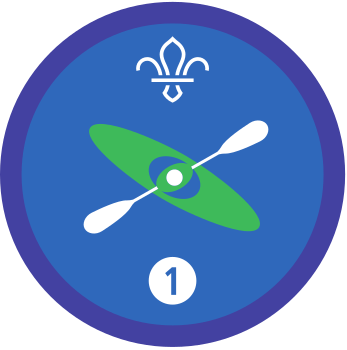Canoeing
What to expect
Canoes are usually paddled by two people – each person has a single-bladed paddle that they use to move the canoe through the water. Canoeing can be quite physically demanding, but it’s up to you whether you aim for a relaxing river trip or a fun-filled activity afternoon.
To get a feel for canoeing before you get on the water, why not learn about different types of watercraft with Which craft?, or get stuck in to some Paddle puzzles?
You could also get in touch with your local Scout Adventures centre – they run sessions and provide permit training and assessments. It’s always worth chatting to your District Commissioner to see if they know of any local permitted providers, too.
Fun facts
Canoeing’s one of the oldest types of travel – people have been using canoes for up to 10,000 years. Traditional canoes were made out of bark, hollowed out tree trunks, or even animal skins and were used for exploring and trade. Now, the canoes you use are likely to be made of plastic or fibreglass – and you’ll probably just use them to have fun and get active.
Handy hints
- Take a water bottle. Canoeing can be hard work, and you might be away from the bank for a while. Take a water bottle so you can stay hydrated on the go.
- Don’t wear your fanciest shoes. Water will probably splash into the canoe and puddle at the bottom, so be prepared for your shoes to get soggy! It’s a good idea to take a spare pair of shoes, a towel, and a spare change of clothes – that way, your journey home will be comfortable whatever happens on your adventure.
- Take a coat in your boat. Even if it’s not raining, lakes and rivers can be windy and cold as you’re a bit more exposed. Take a windproof and waterproof coat with you if you have one – it’ll keep you warm and dry.
Safety
You must always:
- Complete a risk assessment
- Have the right ratios of number of adults to provide suitable supervision
- Set up an InTouch process
- Know what to do in an emergency
- Share information with parents and carers with an activity information form
- Get approval from your commissioner
Be safe in water:
Everyone should be able to swim 50 m wearing the clothing or equipment for the activity. Non-swimmers will need additional support.
Water can be dangerous - be aware of the risks.
The category of water depends on how safe the water is. Use our waterways directory to check.
Be sure to manage the group when near water, keeping everyone safe.
Make sure that all equipment is fit for purpose and in good condition:
Everyone must wear a life jacket or buoyancy aid.
The instructor must make sure boats are seaworthy.
There are regulations you must follow if you are hiring a boat.
Be safe outdoors:
- Check the weather forecast
Joint activities with other organisations:
- This activity can be run jointly with Girlguiding.
- This activity can be run with other organisations.
This activity can be led by you or someone else in Scouts:
The activity leader must have an adventurous activities permit with the right level and permissions for your group.
You don't need a permit for activities on Class C waters (safe, inland water less than 100 m wide).
Where the group is entirely members over the age of 18 the permit scheme does not apply, please follow the rule 9.8 adult groups.
You can go to a centre or use an activity leader who is not part of Scouting:
You must find a suitable provider who meets the following requirements:- The centre/instructor should hold one of these: (If the provider is AALA exempt)
- British Canoeing - Coach Award (level and discipline specific - with appropriate endorsements for the waters being used)
The provider must have public liability insurance.
Guidance
Reflection
Canoe helps people to value the outdoors. It’s a great way for people to get back to nature because they can get around without a noisy engine interrupting (or scaring wildlife). People can also explore the water and see things they wouldn’t be able to see from the shore. Did people enjoy being outside in a canoe? Did it help them feel connected to nature? Do people think it’s important to take care of natural spaces that are used for canoeing?
Canoeing’s also a great way to be active. Did people expect canoeing to be hard work? Was it easier or harder than they expected? What parts of peoples bodies had to work hard during canoeing? Being active’s not just about people moving their bodies – it’s can also be a fun way to build on other skills. Did anyone learn anything new through canoeing? Perhaps some people played their part in a team, got back up and tried again when things went wrong, or gave it a go when they felt nervous. People experience adventures differently, and it’s always interesting to hear someone else’s story.
- Canoeing can often be adapted so more people can give it a go. Many outdoor centres have facilities that cater for people with additional needs and experienced instructors to help everyone achieve their goals. Canoes and paddles can be adapted in all sorts of ways. Get in touch with your local provider to chat through the needs of people in your group – make sure you give them plenty of notice.
- Paracanoe became a Paralympic sport in 2016. Go Paddling has more information about accessible canoeing.
All Scout activities should be inclusive and accessible.
If people enjoyed canoeing, they could put their paddle sports to the test with another paddle sport. If you’re ready to work as part of a bigger team, dragon boating might be right for you. If you’re keen to try something a bit different, why not look into stand up paddleboarding?


